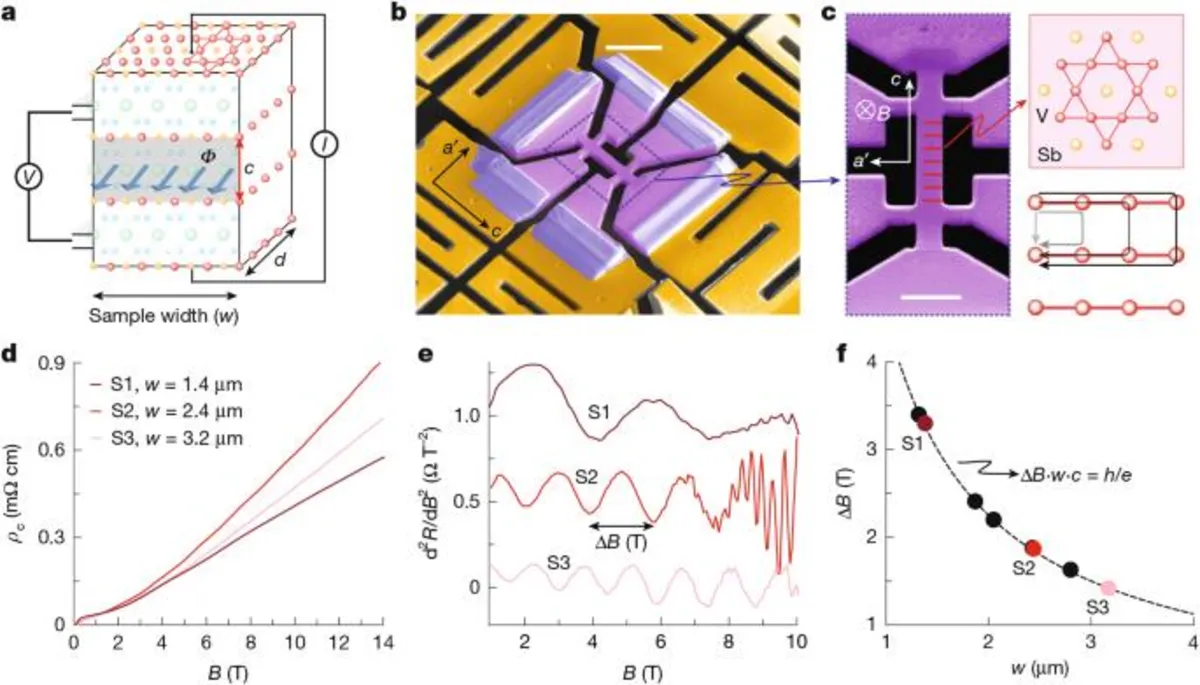
A central goal of contemporary condensed matter physics is the rational design of interacting electronic phases and the emergence of cooperative quantum phenomena driven by electronic correlations. Achieving fine control over electron behavior beyond conventional band-structure engineering holds promise for unlocking exotic response functions and enabling future technologies, particularly those utilizing quantum coherence. One effective strategy to amplify the effects of electronic interactions is to quench the kinetic energy of electrons, thereby localizing them through the engineering of quantum materials where several electronic pathways interfere destructively.
This principle is foundational to the physics of flat-band systems, notably exemplified by magic-angle bilayer graphene. Recent research has also turned attention toward other lattice geometries that support frustrated quantum paths, such as the Lieb and kagome lattices. Among these, the layered kagome superconductor CsV3Sb5 has attracted significant interest due to its complex electronic states. Its charge order at TCDW ≈ 94 K is anticorrelated with its superconducting transition temperature (Tc ≈ 2.8 K), and while some studies suggest that its superconductivity may be unconventional, this remains a topic of ongoing debate.
Perhaps the most compelling open question in this field is the enigmatic change of the electronic ground state at an intermediate temperature scale, T' ≈ 30 K. This phenomenon has been identified by several experimental probes, yet the microscopic nature of this low-temperature state and its potential broken symmetries remain unresolved. A prominent hypothesis posits the emergence of persistent orbital currents, often described as loop currents circulating within the kagome plaquettes.
Recent studies have provided experimental evidence that the state emerging below T' hosts long-range electronic coherence, significantly impacting coherent out-of-plane charge transport. This coherence manifests through interference effects that persist over macroscopic distances spanning several micrometers, remaining robust up to T'. The observed interference patterns in magnetoresistance measurements suggest that this state plays an active role in charge transport.
The central observation of this study is the emergence of field-periodic oscillations in the interlayer magnetoconductance of micron-sized pillars, which effectively act as macroscopic stacks of kagome planes. An electric current is applied along the pillar axis, perpendicular to the kagome layers, while a magnetic field B is oriented in-plane, perpendicular to the sample surface. At temperatures of 2 K and above, the magnetoresistance exhibits a superlinear increase superimposed with pronounced oscillations that are periodic in the magnetic field.
These oscillations persist at higher fields but gradually merge into 1/B-periodic Shubnikov–de Haas oscillations, which eventually obscure their distinct identification in the high-field regime. The oscillation period ΔB is uniquely determined by the magnetic field required to thread a single flux quantum between adjacent kagome planes. This relationship combines the atomic-scale interlayer spacing with the macroscopic device width, which is precisely controlled during fabrication.
The findings presented in this study rely on two recent methodological advances. First, detecting a measurable signal requires averaging over a macroscopic number of identical kagome layers. We utilize focused ion beam (FIB) machining to sculpt bars aligned along the c direction from plate-like single crystals. Second, given that CsV3Sb5 is known to be exceptionally sensitive to strain, careful mechanical decoupling is necessary to avoid unintentional strain from thermal mismatch with the substrate. This is accomplished by suspending the devices on soft SiNx membranes coated with gold for electrical contact.
The oscillations are notably suppressed in substrate-supported devices under typical strain levels, emphasizing the importance of strain management in experimental setups. It is crucial to highlight that the relevant magnetic flux is determined by the spacing between adjacent kagome planes rather than the crystallographic unit cell reconstructed by charge order.
In our experiments, we observed a marked discontinuity in the oscillation behavior when the magnetic field is rotated within the kagome plane. As the field direction is tilted away from the surface normal, the quantum interference process continues to count flux quanta between the planes, and the measured periods grow accordingly. However, at a tilt angle of 45°, the oscillation period exhibits a discontinuous jump, indicating a fundamental change in the system's response.
This behavior strongly contrasts with typical single-particle quantum phenomena, which generally produce characteristic beating patterns. Instead, a single frequency is consistently observed across all angles, suggesting that coherent communication and non-local coupling between surfaces are at play, necessitating a long-range coherent many-body state.
To understand the observed periodic-in-B oscillations, we must narrow the physical regime in which microscopic theories can describe such behaviors. While a natural comparison arises with h/e flux-periodic oscillations reported in ultra-clean layered metals, the underlying mechanisms need not be the same. The observations in CsV3Sb5 suggest that the phenomena may require the coherence of a collective many-body state rather than being solely based on single-particle physics.
Distinct differences between the two systems highlight the unique electronic properties of CsV3Sb5. For instance, while PdCoO2 exhibits several oscillation frequencies at all field angles due to superposed single-particle processes, CsV3Sb5 shows discrete switching between oscillation frequencies, indicating a fundamentally different underlying physics.
In conclusion, these findings support a scenario in which the transition at T' marks the onset of long-range coherence in a many-body state at higher temperatures. The results suggest that this state is sensitive to the geometry and shape of micron-scale confinement, as well as the global rotational symmetry of the three-dimensional crystal structure. Through its phase stiffness, it contributes to charge transport with notable parallels to superconductivity. However, it remains a dissipative state, highlighting the complexity of electronic interactions in kagome metals.
The implications of this research extend beyond fundamental insights into coherent electronic states, potentially paving the way for innovative quantum interference devices that operate at elevated temperatures, where superconductivity may not be present or desirable. As such, CsV3Sb5 emerges as a promising platform for exploring and realizing new coherent electronic states in quantum materials.